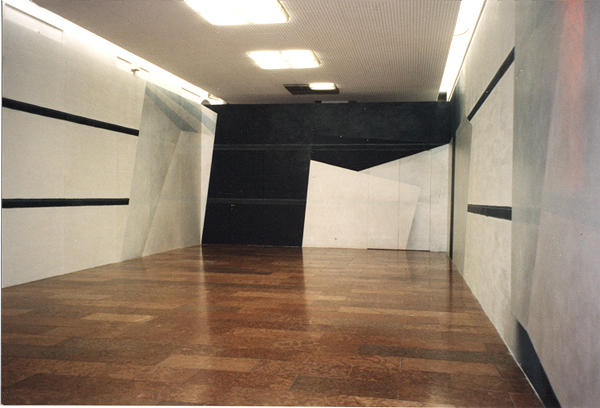During a discussion with Éva Köves, concerning her plans of an action for the Gallery by Night event series, she told me that she would actually prefer to paint a room according to her obsessions: illusory depictions of planes and shadows, projections and contrasts, delicate transitions and sharply distinguished geometrical forms. So I offered her a venue at the Ludwig Museum. It was an intimate space construed by a temporary wall, with two doors on its rear end, i.e., the optically significant wall. Thus, the space became intimate as much as public, an intimate passageway.
… And Éva Köves set about planning. Her very first sketches proved to be exciting. It was surprising to witness that the artist known for her excellent works of small format, often miniature, had both the concept and the courage necessary for the task of painting a nearly one-hundred-square-metre wall surface. It would have come as no surprise if one of the classic, though still young, representatives of this art form, the Austrian Ernst Caramelle, had decided to take on such a task. (Some might remember his work featured at the Land in Sight exhibition at the Műcsarnok in the late 1980’s.)
The experiment turned out to be successful. The space was completely transformed; the disturbing circumstances disappeared, they dissolved into the scenery. With such a generically ephemeral work, of which only its documentation has remained, Köves continued as previously, to paint with shades of white and grey, and a touch of black, on white background with strong and expressive brushstrokes. Her earlier attempts of the 1990’s to depict shadows had already anticipated the pictorial juxtaposition of or confrontation between a geometric structure and a highly sensitive, expressive surface. Such a tension, in the case of this installation, gratified the geometrical structure. Köves, however, had also remained faithful to her former self: the delicate white and grey transitions, with a flat surface mobilised by the sensitive brushstrokes, evoked what had been established by her earlier paintings. And even though the task was to transform the space and evoke the illusion of an altered space, the newly created space did not completely obliterate the architecture of the building itself. It became calm and balanced, freed from the vexed atmosphere of the illusory spaces characteristic of the Baroque.
Katalin Néray

